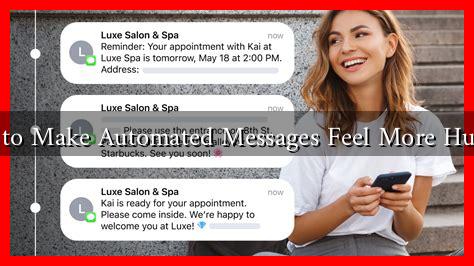-
Table of Contents
- How to Make Automated Messages Feel More Human?
- Understanding the Importance of Human Touch
- Strategies to Humanize Automated Messages
- 1. Use Conversational Language
- 2. Personalization is Key
- 3. Incorporate Emojis and GIFs
- 4. Implement Contextual Responses
- 5. Use a Friendly Signature
- Case Studies: Brands That Excel in Humanizing Automation
- Conclusion
How to Make Automated Messages Feel More Human?
In an increasingly digital world, automated messaging has become a staple for businesses looking to streamline communication. However, one of the biggest challenges is ensuring that these messages feel personal and engaging. A study by Salesforce found that 69% of consumers prefer to interact with a human rather than a bot. This statistic underscores the importance of making automated messages feel more human. In this article, we will explore effective strategies to achieve this goal.
Understanding the Importance of Human Touch
Automated messages can often come across as robotic and impersonal. This can lead to customer frustration and disengagement. To counteract this, businesses must prioritize the human element in their automated communications. Here are some reasons why this is crucial:
- Building Trust: Human-like interactions foster trust and rapport with customers.
- Enhancing Customer Experience: Personalized messages improve overall customer satisfaction.
- Increasing Engagement: Engaging messages lead to higher response rates and customer loyalty.
Strategies to Humanize Automated Messages
To create automated messages that resonate with customers, consider the following strategies:
1. Use Conversational Language
Automated messages should mimic natural conversation. Avoid jargon and overly formal language. Instead, opt for a friendly tone that reflects your brand’s personality. For example:
- Instead of saying, “Your request has been processed,” try “Great news! We’ve taken care of your request!”
- Replace “We appreciate your feedback” with “Thanks for sharing your thoughts with us!”
2. Personalization is Key
Personalizing messages can significantly enhance the human touch. Use customer data to tailor messages based on their preferences, past interactions, or demographics. For instance:
- Address customers by their first name.
- Reference previous purchases or interactions.
- Send birthday greetings or special offers based on customer behavior.
3. Incorporate Emojis and GIFs
Emojis and GIFs can add a playful element to automated messages, making them feel more relatable. A study by Business Insider found that messages with emojis can increase engagement by 48%. Use them sparingly to enhance your message without overwhelming the recipient.
4. Implement Contextual Responses
Contextual responses are crucial for making automated messages feel relevant and timely. Use AI and machine learning to analyze customer behavior and provide responses that align with their current needs. For example:
- If a customer is browsing a specific product, send a message like, “Need help deciding? Here’s what other customers loved about this item!”
- For abandoned carts, a gentle nudge like, “Looks like you left something behind! Can we help you with that?” can be effective.
5. Use a Friendly Signature
Ending messages with a friendly signature can humanize automated communications. Instead of a generic sign-off, use a name or a persona that represents your brand. For example:
- “Cheers, Sarah from Customer Support!”
- “Warm regards, The Friendly Team at [Your Company]!”
Case Studies: Brands That Excel in Humanizing Automation
Several brands have successfully implemented these strategies to humanize their automated messages:
- Sephora: The beauty retailer uses personalized recommendations and friendly language in their automated messages, resulting in higher customer engagement.
- Slack: Their automated responses are conversational and often include humor, making users feel more connected to the brand.
Conclusion
In a world where automated messaging is becoming the norm, making these communications feel more human is essential for building strong customer relationships. By using conversational language, personalizing messages, incorporating emojis, implementing contextual responses, and using friendly signatures, businesses can create a more engaging and relatable experience for their customers. As technology continues to evolve, the human touch will remain a critical component of effective communication. By prioritizing these strategies, brands can not only enhance customer satisfaction but also foster loyalty and trust in an increasingly automated world.

